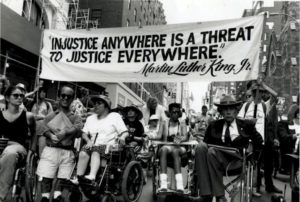 Political Science
Political Science  1 Comment
1 Comment Disabled, Not Disempowered
I’ve been an activist since high school. Administrators made a rule that t-shirt sleeve headbands we used to hold back floppy skater hair were the same as hats (and therefore forbidden) when worn by boys. We organized a direct action to have all the girls wear them for one school day, and we delivered a letter to the front office threatening a Title IX suit for gender discrimination.
They reversed the policy.
I’m also a political junkie. I prefer issue politics, which build bridges of common values across otherwise insurmountable obstacles, to electoral politics. But my values compel me work in that arena too.
Here’s my problem, though: I have a chronic pain disorder, as well as various mental health issues, which combine to keep me from being as present physically as I want to be. Marches and rallies, door-knocking and phone-banking, they can all be too much for my health. Missing those things leaves me feeling ineffective and isolated from the people and experiences that contribute to a sense of connection that’s even more of a reward than the actual work.
But there are things that people with physical and mental disabilities can do to contribute meaningfully. Here are some of the ways I try to have an impact with what I’ve got.
1) Advocate for disability accommodations in political and activist spaces. There’s a real effort right now to make social justice movements intentionally inclusive. Elders and youth share power and responsibility more evenly. Folks commonly state their pronouns during introductions. Translators are frequently available. But disability issues are often left out of consideration.
So contact campaigns and groups and find out if their meeting places are disability accessible, to make them aware of barriers like stairs and narrow doors (common in churches, which provide cheap locations for large groups). Reach out to protest organizers to request march details so you can participate at the beginning or end locations. Help them devise routes that are safer for low-mobility attendees. Convince them to provide sign language interpreters and crisis support for folks who may be anxious in large crowds or triggered by the presence of aggressive law enforcement or counter-protesters.
2) Share information and messages in social media spaces. Some people brand this as “slacktivism,” but there are countless movements that wouldn’t have the global reach and organizing power they’ve achieved without Facebook, Twitter, Instagram, or Tumblr. Share livestreams, amplify hashtags, invite people to events, and aggregate links and facts so people can find centralized information.
3) Volunteer from home. It’s still standard for people to go to a central location to make calls in support of a campaign, but there are plenty of tools out there now that allow people to do the same work from home with a laptop and phone. Even patch-thru phonebanks, one of the most highly effective tools for getting people to take a simple action like send a message to their legislators, can be done from home. If it’s difficult for you to get to an office, ask the campaign to set you up to work at home. Data entry is equally valuable and accessible at home.
4) Raise money for the cause. This one feels impossible sometimes, because disabled people are so often under- or unemployed, or on a fixed income. But we have the same networks of friends, family, and acquaintances, and the values we share with those people can motivate them to donate. Surprisingly often, the only thing that keeps them from doing that is that no one has asked. Explain why you think it’s important, connect it to your shared values so they see their self-interest in it, and ask them for an amount that would be meaningful. Sure, some will say no, and that shouldn’t make you shame or failed. But you can’t know unless you ask, and people will surprise you all the time.
5) Create things. Your contribution to an effort can be measured in time, treasure, and talent. If the first two are difficult because of your physical and financial resources, you need to know that the third is just as valuable. For example, an army moves on its stomachs, as the old saying goes. Campaign workers and volunteers basically live on junk food, pizza, and coffee, and anyone who brings in a crockpot of anything healthy and homemade becomes their favorite person.
Art is just as important. Striking graphics, clever memes, and meaningful signs and banners are essential to the visuals that move people to action. Stories are the most compelling tool we have change hearts and minds on an issue, so write about why these things matter so much to you. And if you’re gifted enough to draw, paint, stitch, or craft objects that others might want, you can accomplish more of #4 with your skills.


Jessica, your blog will soon be added to our Actually Autistic Blogs List (anautismobserver.wordpress.com). Please click on the “How do you want your blog listed?” link at the top of that site to customize your blog’s description.
Thank you.
Judy (An Autism Observer)